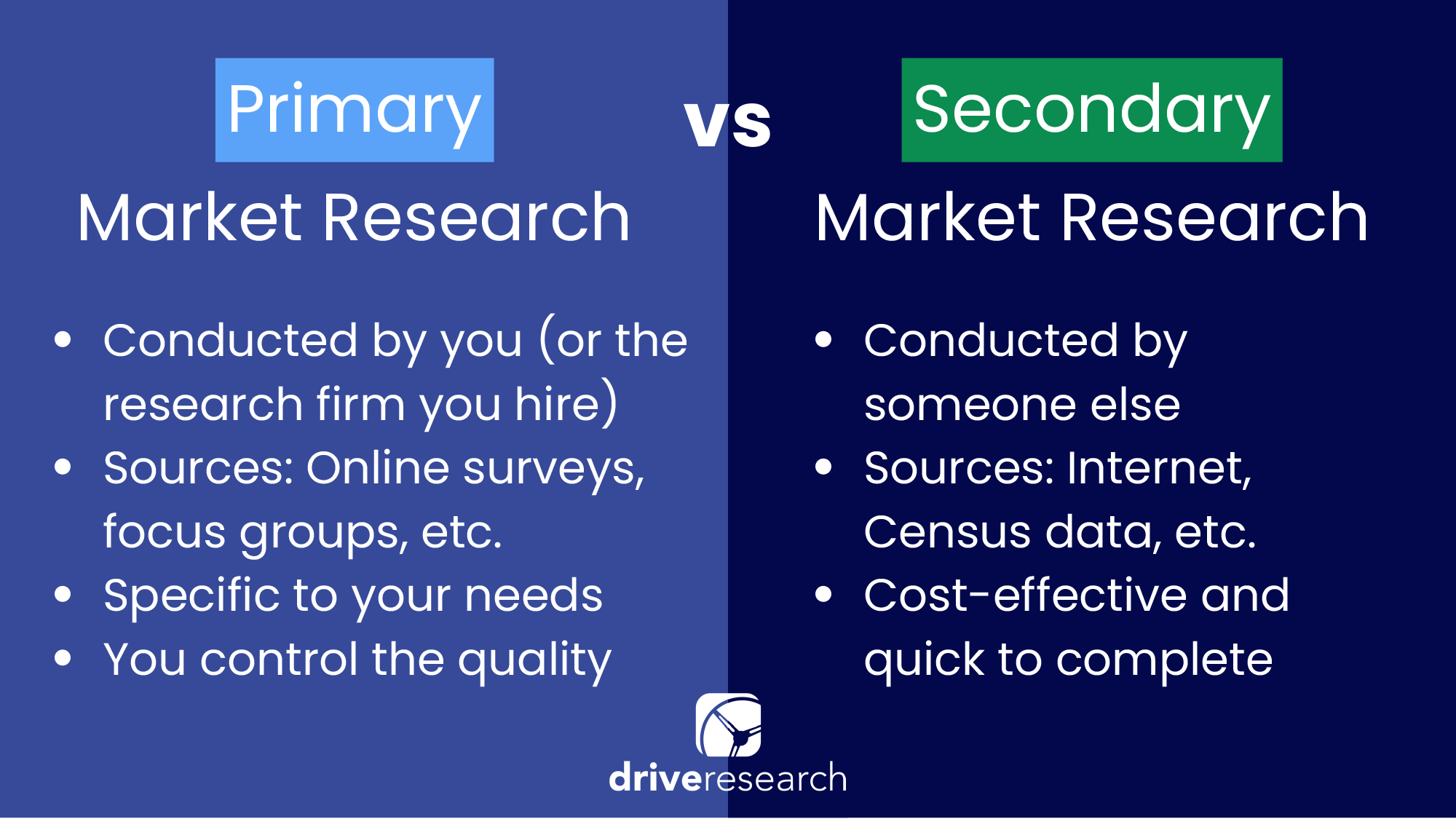
Organizations and researchers are constantly seeking ways to explore and understand the vast array of topics that pique their interest.
One invaluable tool at their disposal is secondary research also, known as desk research.
Essentially secondary research means it’s data and research collected by someone else. This includes analyzing data prepared by other industry experts or syndicated databases.
While primary research involves collecting data firsthand, secondary research harnesses the wealth of existing information already available.
In this blog post, our market research company delves into the world of secondary research, exploring its definition, advantages, limitations, and practical applications.
What is Secondary Research?
Secondary research refers to the process of gathering and analyzing existing data and information that has been collected by someone else for a different purpose.
It involves the use of existing sources such as books, articles, reports, surveys, and databases to obtain insights and knowledge on a specific topic or research question.
Unlike primary research, which involves collecting data firsthand through surveys, interviews, experiments, or observations, secondary research relies on previously published or recorded information.
This data can be accessed from various sources, including academic journals, government publications, market research reports, industry studies, and online databases.

How To Conduct Secondary Research
A secondary search can prove to be valuable in several market research settings.
Let's say the goal of a research study is to understand customer satisfaction with the laundry detergent Tide. Secondary research can be utilized to gather data on average laundry detergent usage in the U.S., possibly even the number of individuals who use Tide.
Another common application of secondary research is to complete a competitive assessment. Public information like company offerings and customer experiences can be used to paint a picture of each competitor in the market.
Sometimes the overall market is the focal point of the secondary search.
In fact, it is not uncommon for the goal of a study to be the identification of market trends for a particular industry. A summary of the latest moves and developments in a market can be just as advantageous for a business strategy as primary research.
How to Find Secondary Research
Conducting secondary research may seem easier than primary research, but sometimes it can feel like you are trying to find a needle in a haystack.
Also, the time it takes to compile all of the information needed can take just as long as collecting data through primary research, but there are some important sources that can be used to start your search off strong!
Paid versus free to access? Scholarly papers versus opinion editorials? Print versus online?
It is likely a secondary search may be some combination of all of these. The needs of a project will determine where the search ultimately leads.
Sources to consider using for secondary research include:
- Census.gov/data
- Demographics Now/eSite analytics
- Nielsen
- Business journals
- News articles
- Company websites
- Published research reports
- Online conversations
There are several secondary research vendors and data available for a market research firm.
Some of the more popular 3rd party data sources include Census data or Nielsen data.
Conducting Secondary Research with Nielsen
With Nielsen data, users are provided with a mass amount of data for the designated market areas (DMAs) to buy into. These databases work off of yearly contracts in which users buy the ability to access the data.
The Nielsen survey uses 2,000 completes per DMA and collects information on everything from basic household demographics to the number of homes that have solar panels.
Nielsen uses a 15-minute phone survey with a follow-up 45-minute mail survey to collect this data.
It is widely known as one of the most popular secondary data sources in the country.
In addition to being comprehensive, buying into Nielsen can also be an expensive venture.
It’s important to keep in mind not all secondary research sources are free and usually, the paid sources are the most helpful and organized.
Benefits of Secondary Research
Primary research such as online surveys and focus groups are great because it’s the data is timely/the most up to date and it can be customized to the unique needs of a research project.
However, the fatal flaw of primary research is the inability to accurately measure previous habits to add context to the primary data collected.
Secondary research means spending time collecting and analyzing previously collected data/information.
Again, while it can take some time to collect, the information can be extremely valuable to help make decisions or even use as a benchmark to help add context to primary data being collected.
Benefits of secondary data collection include:
- Vast amounts of data from a variety of sources
- Ability to create insights from previous research
- Typically less expensive than primary research
- Collecting secondary data through a third party ensures an unbiased interpretation of the data
- Adds context to primary research
If you're looking to conduct market research on a budget, I recommend reading What is the Most Cost-Effective Market Research Methodology?
Examples of Secondary Research
1. Choosing a location
An example of secondary research could be analyzing 15 different designated market areas (DMAs) or metro areas.
The 15 markets would be pre-determined by the client. Various paid syndicated data sources and publicly available information would be used to source data.
Topics for the secondary research include:
- Employment capacity: Using data from the U.S. Census and state resources
- Occupational supply & demand: Leveraging Bureau of Labor statistics
- Political factors: Articles and information posted by state and local sources
- Competitive data: Competitor websites, marketing, media kits, and pricing information
- Other(s): Up to 3 other factors to be reviewed in the scope
Each indicator will be weighted in terms of importance. The matrix will use those weights and create a high-level scoring or rating for each factor and market.
The final deliverable for this research is the creation of a comprehensive Excel database of data and information for each of the indicators.
2. Understanding target demographics
Here is another example of conducting secondary search.
Let's say you want to learn about the demographics of construction workers in the U.S. You might begin with an online search of these keywords.
One of the results could be a recent research study on the profile of construction workers. Once you can verify the source is reliable, this information could be the ticket to answering your questions.
Data such as gender, ethnicity, income, and language spoken at home is now hypothetically at your disposal.
An investigative report on the New York Times could give you equally valuable information from that initial online search.
Additionally, places like Census.gov, business journals, news articles, company websites, and more related are great places to find such info.
FAQ About Secondary Research
1. What is secondary research and the purpose?
The goal of secondary research is to examine the data collected from prior studies and apply it where it makes sense in the context.
2. How do you identify secondary research?
Secondary sources can be found in books, government sites, research journals, business websites, or other Internet resources.
Most of the time secondary research refers to published material, rather than supplementary material like bibliographies, encyclopedias, handbooks, and so forth.
Final Thoughts
Secondary research, with its vast array of existing data and information, has proven to be a valuable resource for researchers, professionals, and enthusiasts alike.
By tapping into the wealth of knowledge already available, we can unlock new insights, validate hypotheses, and gain a deeper understanding of various subjects.
Whether it's for academic pursuits, business decision-making, or personal exploration, harnessing existing information empowers us to uncover hidden connections, make informed decisions, and contribute to the collective pool of knowledge.
Contact Our Full-Service Market Research Firm
Drive Research is a national market research company specializing in both primary and secondary research methods. Our team of certified professionals can recommend the best approach for meeting your unique project objectives, goals, timeline, and budget.
To learn more about our services, contact Drive Research today.
- Message us on our website
- Email us at [email protected]
- Call us at 888-725-DATA
- Text us at 315-303-2040

Emily Taylor
As a Senior Research Analyst, Emily is approaching a decade of experience in the market research industry and loves to challenge the status quo. She is a certified VoC professional with a passion for storytelling.
Learn more about Emily, here.
This article was originally posted in June 2016 but has since been updated in November 2021.

